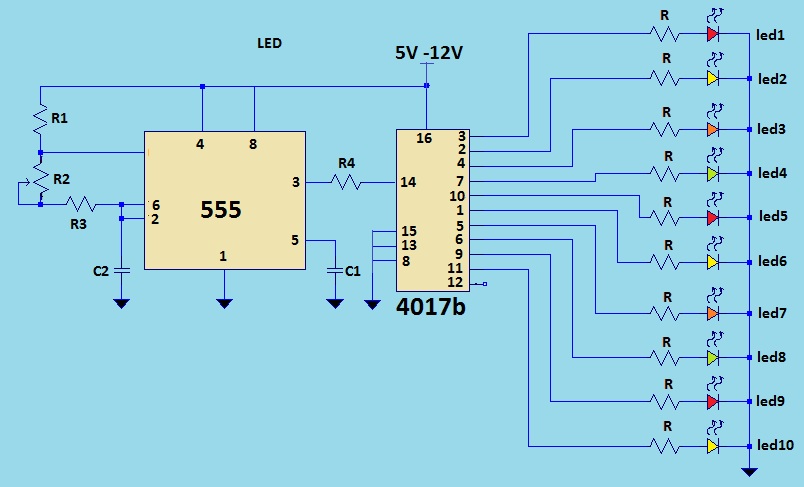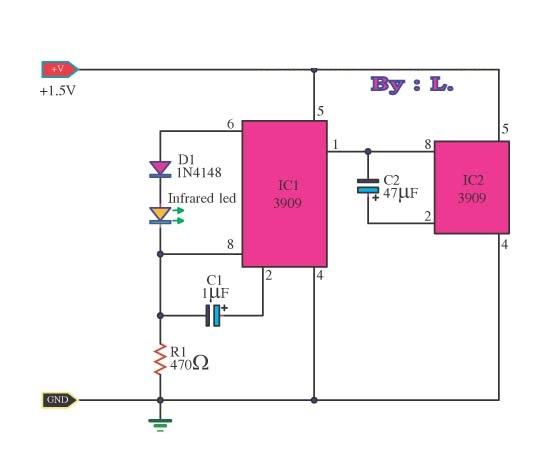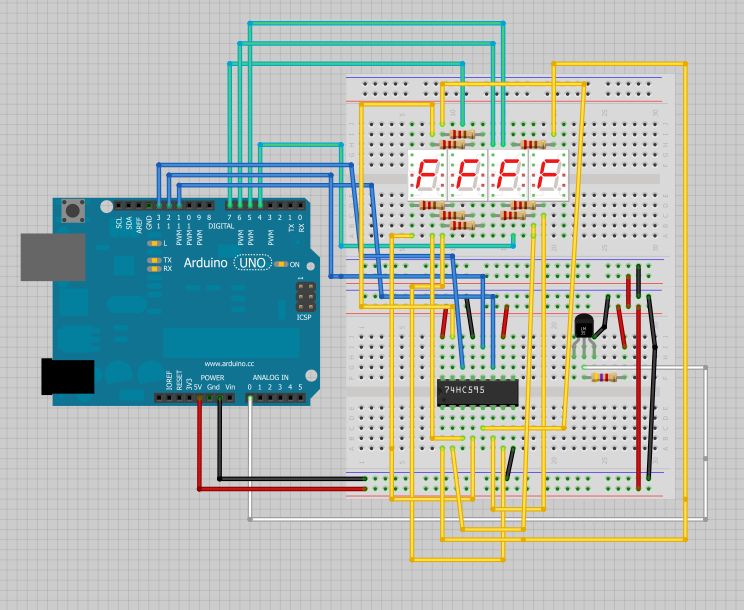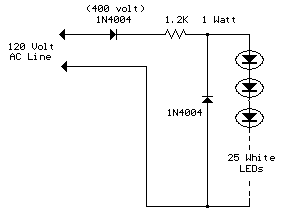
Simple Twi-light using white LEDs
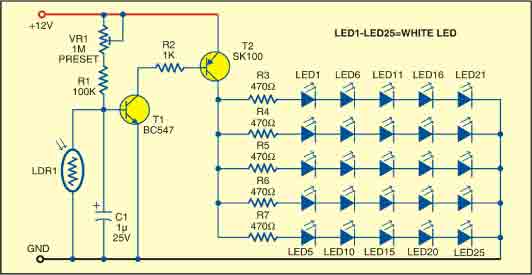
This sunlight-controlled lamp utilizes a light-dependent resistor (LDR) as the sunlight sensor and comprises a total of 25 high-brightness white LEDs. Each row of LEDs is connected in series with separate resistors. The operation of the circuit is straightforward. During the daytime, light illuminates the LDR1, resulting in low resistance. Consequently, both transistors (T1 and T2) remain non-conductive, and the LEDs (LED1 through LED25) do not illuminate. Conversely, at nighttime, the absence of light on LDR1 causes it to exhibit high resistance. This leads to the conduction of transistors T1 and T2, allowing the LEDs (LED1 through LED25) to light up. The circuit should be assembled on a general-purpose PCB and housed in a cabinet. The LEDs (LED1 through LED25) and LDR1 should be positioned on the top of the enclosure. It is essential to orient the unit so that sunlight directly reaches LDR1 during the daytime. For powering the circuit, a 12V battery or any 12V adapter is recommended.
This sunlight-controlled lamp circuit is designed to automatically illuminate LEDs based on ambient light conditions. The core component, the light-dependent resistor (LDR), serves as a sensor that detects the intensity of sunlight. When exposed to light, the LDR's resistance decreases, preventing the transistors T1 and T2 from conducting. This effectively keeps the LEDs off during the day, conserving energy and extending the lifespan of the components.
In contrast, during nighttime or in low-light conditions, the LDR's resistance increases significantly. This change allows the transistors T1 and T2 to enter the conductive state, completing the circuit and enabling the 25 high-brightness white LEDs to illuminate. The use of high-brightness LEDs ensures that the lamp provides adequate light output for various applications, such as garden lighting or decorative illumination.
The circuit design incorporates resistors in series with each row of LEDs to limit the current, thus protecting the LEDs from potential damage due to excessive current flow. Proper selection of resistor values is crucial to maintain the desired brightness while ensuring the longevity of the LEDs.
Assembly of the circuit on a general-purpose PCB facilitates easy integration of components and provides a stable platform for operation. The enclosure should be designed to shield the internal components from environmental factors while allowing sufficient exposure of the LDR to sunlight. The placement of the LDR on the top of the enclosure is critical for optimal performance, ensuring it receives direct sunlight during daytime hours.
Powering the circuit with a 12V battery or adapter provides flexibility in deployment, allowing for both portable and stationary applications. The circuit can be utilized in various settings, including outdoor lighting solutions, where automatic operation based on sunlight is advantageous. Overall, this circuit exemplifies a practical application of basic electronic components to achieve an energy-efficient lighting solution.This sunlight-controlled lamp uses a light-dependent resistor (LDR) as the sunlight sensor and a total of 25 high-brightness white LEDs. Separate resistors are connected in series with each row of the LEDs. The working of the circuit is very simple. During daytime, light falls on the LDR1 and it offers a low resistance. As a result, both the trans istors (T1 and T2) do not conduct and the LEDs (LED1 through LED25) do not glow. On the other hand, during nighttime, the light does not fall on LDR1 and it offers a high resistance. As a result, transistors T1 and T2 conduct and the LEDs (LED1 through LED25) glow. Assemble the circuit on a general-purpose PCB and enclose in a cabinet. Connect the LEDs (LED1 through LED25) and LDR1 on top of the box. Place the unit such that during daytime the sunlight falls directly on LDR1. For powering the circuit, use a 12V battery or any 12V adaptor. 🔗 External reference
This sunlight-controlled lamp circuit is designed to automatically illuminate LEDs based on ambient light conditions. The core component, the light-dependent resistor (LDR), serves as a sensor that detects the intensity of sunlight. When exposed to light, the LDR's resistance decreases, preventing the transistors T1 and T2 from conducting. This effectively keeps the LEDs off during the day, conserving energy and extending the lifespan of the components.
In contrast, during nighttime or in low-light conditions, the LDR's resistance increases significantly. This change allows the transistors T1 and T2 to enter the conductive state, completing the circuit and enabling the 25 high-brightness white LEDs to illuminate. The use of high-brightness LEDs ensures that the lamp provides adequate light output for various applications, such as garden lighting or decorative illumination.
The circuit design incorporates resistors in series with each row of LEDs to limit the current, thus protecting the LEDs from potential damage due to excessive current flow. Proper selection of resistor values is crucial to maintain the desired brightness while ensuring the longevity of the LEDs.
Assembly of the circuit on a general-purpose PCB facilitates easy integration of components and provides a stable platform for operation. The enclosure should be designed to shield the internal components from environmental factors while allowing sufficient exposure of the LDR to sunlight. The placement of the LDR on the top of the enclosure is critical for optimal performance, ensuring it receives direct sunlight during daytime hours.
Powering the circuit with a 12V battery or adapter provides flexibility in deployment, allowing for both portable and stationary applications. The circuit can be utilized in various settings, including outdoor lighting solutions, where automatic operation based on sunlight is advantageous. Overall, this circuit exemplifies a practical application of basic electronic components to achieve an energy-efficient lighting solution.This sunlight-controlled lamp uses a light-dependent resistor (LDR) as the sunlight sensor and a total of 25 high-brightness white LEDs. Separate resistors are connected in series with each row of the LEDs. The working of the circuit is very simple. During daytime, light falls on the LDR1 and it offers a low resistance. As a result, both the trans istors (T1 and T2) do not conduct and the LEDs (LED1 through LED25) do not glow. On the other hand, during nighttime, the light does not fall on LDR1 and it offers a high resistance. As a result, transistors T1 and T2 conduct and the LEDs (LED1 through LED25) glow. Assemble the circuit on a general-purpose PCB and enclose in a cabinet. Connect the LEDs (LED1 through LED25) and LDR1 on top of the box. Place the unit such that during daytime the sunlight falls directly on LDR1. For powering the circuit, use a 12V battery or any 12V adaptor. 🔗 External reference
Warning: include(partials/cookie-banner.php): Failed to open stream: Permission denied in /var/www/html/nextgr/view-circuit.php on line 713
Warning: include(): Failed opening 'partials/cookie-banner.php' for inclusion (include_path='.:/usr/share/php') in /var/www/html/nextgr/view-circuit.php on line 713
